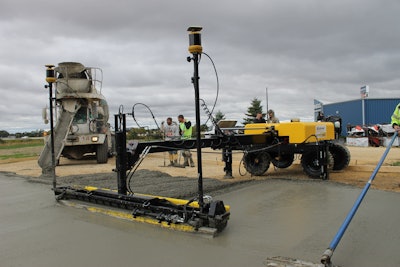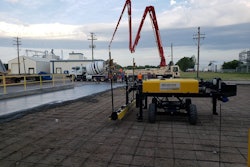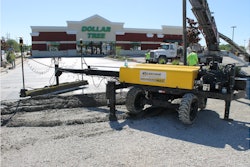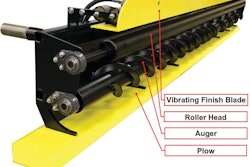
Screeding is the process in which a concrete finisher cuts off excess wet concrete to bring the top surface of a slab to the proper grade and smoothness. Traditionally, concrete contractors can perform this task using a flat board or an aluminum tool after the concrete has been placed. Through the years however, technology has improved the process and many contractors are realilzing positive impacts on labor and material costs while also increasing profits.
One of the latest developments in concrete screeding comes from Ligchine International. The company has partnered with Topcon Positioning Systems to offer the GPS/Laser controlled 3D screeding system. The combination of Ligchine’s Boom operated ScreedSaver machines and Topcon’s Millimeter GPS/Laser System offers significant labor savings, high volume production and precision accuracy for 3D contour concrete placement.
While Topcon GPS systems can be found on dozers, motor graders, curb machines, excavators, scrapers and asphalt pavers, the partnership between the two companies now makes GPS control available on screeds.
Concrete Contractor spoke with four contractors who are discovering the benefits of the 3D screeding system and the niche applications where the machine is being used.
Road Systems and On/Off Ramps
Charlie Getka, owner of Straight Edge Concrete, Elkhorn, Wisconsin, is an experienced concrete contractor with background as a superintendent at a major road contractor and as well as serving at a major construction company focusing on sewer and water construction. When he bought out the concrete division at his previous employer he decided to start his own contracting business.
Getka purchased the Ligchine ScreedSaver MAX in September 2014. The machine features a larger boom extension screed and integrates the technologies of the standard ScreedSaver II with the added features of four-wheel stability combined with front wheel drive and rear wheel steering, a 90-degree pivoting drive frame; and a 35 hp Diesel motor. MAX is also a wireless remote controlled screed.
His contracting business focuses on road systems, specifically on/off ramps and turnabouts and he says without this machine, he would never consider bidding on some jobs because he would not be able to move as much concrete with a six man crew. But the GPS capabilities is what sold him on the machine.
“GPS is becoming the standard in the construction industry and to have GPS capability opens doors for our business,” he says. “Learning the GPS and scanning functionality was probably the trickiest part. With the projects we are involved with, there are break points in every direction, pitch changes, and screeding in a circle makes things a little tougher. With this machine however, it’s point and shoot. We can scan in our brake points and set it up.“
Getka says the labor savings has been a welcome benefit to using the machine. “Normally we could only screed 16 or 24 feet at a time. I can now screed 48 feet and the whole intersection at once. For us, the machine offers less labor, which equates to less time to the do the job and fewer guys on site.”
“If I can push 100 yards of concrete with five to six guys using traditional methods, I can push 500 to 600 yards of concrete with the same crew, invoice that many more dollars which translates to more profit for the company. This machine has been a win-win for all of us.”
Parking Lot Construction
Mel Griess is the Vice President of Operations at Lacy Construction, a general contractor based in Grand Island Nebraska. He has been with the company for 31 years and has a principle area of responsibility and expertise in the field operations side of the business. He is certified as an ACI Flatwork contractor and specializes in flatwork.
Like Getska, he purchased the Ligchine ScreedSaver MAX in the Fall of 2014. When purchasing the machine, he chose to upgrade it to include tracks instead of the standard rubber drive wheels as well as the Topcon Millimeter GPS/Laser System.
Lacy Construction primarily performs work for new construction commercial parking lots with the Ligchine machine. For a long time, the cost of oil drove the price of asphalt to a level where owners of commercial buildings were demanding concrete parking lots versus asphalt. This economic driver enabled Griess to place a lot of parking lots with the machine while the market leveled out. The increase in requests for new concrete parking lots allowed Griess and his crew to utilize the machine frequently while also becoming more efficient at performing the job.
Prior to owning the Ligchine machine, Griess placed concrete parking lots using a truss screed. He says the truss screed was fine in performing the job, however, being careful to set the forms correctly and hitting the lines of flow for the sheet drawing became limiting.
“When using the truss screed, to keep things consistently of a high-quality, we needed to place concrete at no more than 40 feet wide. Now we are able to place concrete parking lots at 100 feet wide and 300 feet long with the only limiting factor being the ability for batch plants to keep up.”
The GPS feature was also a driver for Griess to purchase the machine.
“There are a lot of ups and down in parking lots and the GPS feature has allowed us to perform the job more efficiently and our customers are amazed at how flat the final product displays.”
This was the first time Griess and his crew had worked with GPS. Extensive training with both Ligchine and Topcon was a key factor in becoming familiar with the technology making the adoption of technology easier throughout the company.
Adapt to Technology
If a contractor wants to remain viable in the foreseeable future, adapting to new technologies is critical.
“It becomes important because it is an avenue of competition. The present technology enables us to price things competitively and yet have a high degree of quality at the same time,” Griess says. “My business partner, Jerry Huismann is very progressive and supports utilizing new technology. Working with some of the older guys on our crew was tough but as we introduced this new kind of technology they embraced it too.”
The operator uses a CAD drawing, an electronic file or the surface of the job and plugs the information into the electronics module for the Ligchine machine. The information is processed by the Topcon electronics in the base station and the screed is able to identify areas for adjustment while screeding. According to Griess, the total station unit reaches accuracy points of plus or minus 1/16th of an inch.
“We took it a step beyond and put the Topcon electronics on our motor grader and we can do the same thing now,” Griess exclaims. “If we have to grade the parking lot prior to placing the concrete, we can go in and do that. We can grade it out with the same CAD file, bump it up to however thick the surface might be and away we go with the placing operation.”
Griess not only uses the machine for parking lot jobs, but also for interior floors. “We go both ways with it and that’s very beneficial to what we do.”
Large Scale Patchwork
Felix Construction, based in Carroll, Ohio has been in business since 1971. It’s a family business that at the time, 90 percent of the contractor’s business was in the residential segment. In 2004, however, President and CEO, Jerry Canini and his brother, Victor, vice president, found a niche in parking lot repair at distribution centers for major retailers.
Depending on the season, the contractor will run a crew of 10 to 12 men. Since purchasing the Ligchine screed, Canini says he is now running a crew of five to six men. “That was the main reason we purchased the machine, it’s becoming harder and harder to find quality labor. We own a truss screed and a roller screed; we have them all and they all have a particular job to complete. Now we have the GPS 3D screed and it eliminates labor and does a great job…it shows up to the jobsite every day.”
Canini states that the Ligchine Max has made the whole labor process easier by completing jobs with less labor and less time on site. “It’s a big factor for my niche, being able to complete multiple areas in one day and keeping us on schedule.”
The machine has also helped with Canini’s material costs. “Our costs have dropped this year. We are doing a better job grading and we can do more as far as slopes where our previous piece of equipment was somewhat limited.”
Custom 3D Screeding
Gemstone Masonry Operating Company Inc., based in Frazee, Minnesota began business as a fireplace building company. The economic crash of 2008 forced the company to look at other ways to diversify the business and that’s when the company expanded into custom concrete work. Traditionally the contractor primarily focused on residential jobs, but as the business transformed, so did the type of work. Now, the contractor performs much of their work in schools, healthcare facilities and parking lots.
In the spring of 2014, the contractor purchased the machine and started to use it on a variety of jobs. At that time, Jeremy Shepersky, laser screed operator, estimator and project manager and his crew were still doing quite a bit of residential and commercial work ranging from a small 2,000 square foot home which is a fairly small job to jobs up to 30,000 square feet.
“We started using the machine in these small spaces because it is small enough to maneuver around pipes and tight spaces,” Shepersky says. “If we can get it into a tight spot, we’ll use it. This was our time to really learn how to use the machine. And we discovered the machine was so accurate it eliminated much of our labor requirements.”
But for Shepersky, the purpose of the machine was to use it as an entry point into renting the machine out and performing custom work. The company decided it was time to purchase the Topcon GPS unit for the machine.
“It took about mid-way through the year before the custom work took off,” he says. “Our goal was to create a new revenue stream for the company and we expect it to be a big portion of our business.”
According to Shepersky, the machine has proven to be worth the investment. “A lot of times we have 12 to 13 men on a jobsite. In the beginning, we noticed it would save our labor and our crew size was reduced to eight men. It doesn’t take long to see how it will save you money. And the end product is flat. There are no bumps or humps.”
Since putting the machine into service, Gemstone Masonry Operating Company Inc. has taken on a number of custom jobs, but mostly parking lots.
“Since the word got out that we have this machine, we were able to take it on jobs anywhere from 10,000 square feet to 30,000 square feet and we’re completing them with eight to nine men.”
Sheperkey admits, the technology adaption had its learning curves, but the company has come out on top with increased profits and has added a revenue stream that wasn’t previously available.
“As a contractor, if you don’t adapt to the technologies available, you will be left behind,” he says. “What we can do with the 3D system is unbelievable and certainly creates a competitive advantage in our area.”
Technology has enabled these contractors to realize labor savings, reduced material costs and increased efficiency, accuracy and profits. As the saying goes, there just might be “a better mouse trap” to get the job the done.



















